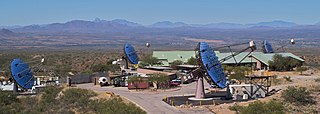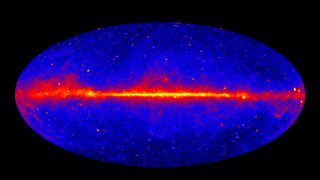Related Research Articles

Sandra Moore Faber is an American astrophysicist known for her research on the evolution of galaxies. She is the University Professor of Astronomy and Astrophysics at the University of California, Santa Cruz, and works at the Lick Observatory. She has made discoveries linking the brightness of galaxies to the speed of stars within them and was the co-discoverer of the Faber–Jackson relation. Faber was also instrumental in designing the Keck telescopes in Hawaii.
Andreja Gomboc is a Slovenian astrophysicist.
Amy J. Barger is an American astronomer and Henrietta Leavitt Professor of Astronomy at the University of Wisconsin–Madison. She is considered a pioneer in combining data from multiple telescopes to monitor multiple wavelengths and in discovering distant galaxies and supermassive black holes, which are outside of the visible spectrum. Barger is an active member of the International Astronomical Union.

VERITAS is a major ground-based gamma-ray observatory with an array of four 12 meter optical reflectors for gamma-ray astronomy in the GeV – TeV photon energy range. VERITAS uses the Imaging Atmospheric Cherenkov Telescope technique to observe gamma rays that cause particle showers in Earth's atmosphere that are known as extensive air showers. The VERITAS array is located at the Fred Lawrence Whipple Observatory, in southern Arizona, United States. The VERITAS reflector design is similar to the earlier Whipple 10-meter gamma-ray telescope, located at the same site, but is larger in size and has a longer focal length for better control of optical aberrations. VERITAS consists of an array of imaging telescopes deployed to view atmospheric Cherenkov showers from multiple locations to give the highest sensitivity in the 100 GeV – 10 TeV band. This very high energy observatory, completed in 2007, effectively complements the Large Area Telescope (LAT) of the Fermi Gamma-ray Space Telescope due to its larger collection area as well as coverage in a higher energy band.

Feryal Özel is a Turkish-American astrophysicist born in Istanbul, Turkey, specializing in the physics of compact objects and high energy astrophysical phenomena. As of 2020, Özel is a professor at the University of Arizona in Tucson, in the Astronomy Department and Steward Observatory.

Gamma-ray astronomy is the astronomical observation of gamma rays, the most energetic form of electromagnetic radiation, with photon energies above 100 keV. Radiation below 100 keV is classified as X-rays and is the subject of X-ray astronomy.

The Astronomical Institute of the Czech Academy of Sciences is a scientific institute headquartered at the Ondřejov Observatory, roughly 35 km southeast of Prague, Czech Republic.

Alicia Margarita Soderberg is an American astrophysicist who is an assistant professor of Astronomy at Harvard University and a postdoctoral fellow at the Harvard–Smithsonian Center for Astrophysics whose research focuses on supernovae.

Priyamvada (Priya) Natarajan is a professor in the departments of astronomy and physics at Yale University. She is noted for her work in mapping dark matter and dark energy, particularly with her work in gravitational lensing, and in models describing the assembly and accretion histories of supermassive black holes. She authored the book Mapping the Heavens: The Radical Scientific Ideas That Reveal the Cosmos.

Belinda J. Wilkes is a Senior Astrophysicist at the Smithsonian Astrophysical Observatory (SAO) in Cambridge, Massachusetts, US, and former director of the Chandra X-ray Center.

Claudia Megan Urry is an American astrophysicist, who has served as the President of the American Astronomical Society, as chair of the Department of Physics at Yale University, and as part of the Hubble Space Telescope faculty. She is currently the Israel Munson Professor of Physics and Astronomy at Yale University and Director of the Yale Center for Astronomy and Astrophysics. Urry is notable not only for her contributions to astronomy and astrophysics, including work on black holes and multiwavelength surveys, but also for her work addressing sexism and gender equity in astronomy, science, and academia more generally.
Multi-messenger astronomy is astronomy based on the coordinated observation and interpretation of disparate "messenger" signals. Interplanetary probes can visit objects within the Solar System, but beyond that, information must rely on "extrasolar messengers". The four extrasolar messengers are electromagnetic radiation, gravitational waves, neutrinos, and cosmic rays. They are created by different astrophysical processes, and thus reveal different information about their sources.

Vassiliki Kalogera is a Greek astrophysicist. She is a professor at Northwestern University and the Director of the Center for Interdisciplinary Exploration and Research in Astrophysics (CIERA). She is a leading member of the LIGO Collaboration that observed gravitational waves in 2015.
Jedidah C. Isler is an American astrophysicist and educator and an active advocate for diversity in STEM. She conducts research on blazars and examines the jet streams emanating from them. She is currently an Assistant professor of Astrophysics at Dartmouth College. She completed a PhD in Astrophysics at Yale in 2014, becoming the first African-American woman to do so.

Erika Tobiason Hamden is an American astrophysicist and Assistant Professor at the University of Arizona and Steward Observatory. Her research focuses on developing ultraviolet (UV) detector technology, ultraviolet–visible spectroscopy (UV/VIS) instrumentation and spectroscopy, and galaxy evolution. She served as the project scientist and project manager of a UV multi-object spectrograph, FIREBall-2, that is designed to observe the circumgalactic medium (CGM). She is a 2019 TED fellow.

Rita M. Sambruna is an Italian-American astrophysicist and is the Deputy Director of the Astrophysics Science Division at National Aeronautics and Space Administration's (NASA) Goddard Space Flight Center. Sambruna held the Clare Boothe Luce Professorship in Physics and Astronomy at George Mason University.
Brenda Lynn Dingus is an American particle astrophysicist at the Los Alamos National Laboratory, known for her research on gamma-ray bursts and cosmic rays.
Elizabeth Anne Hays is an American astrophysicist at the NASA Goddard Space Flight Center, where she is chief of the Astroparticle Physics Laboratory and the project scientist for the Fermi Gamma-ray Space Telescope. Her research has included gamma-ray astronomy of the Crab Nebula, novae, and gamma-ray bursts.
Lucy Frear Fortson is an American astronomer known for her work on gamma-ray astronomy and Galaxy morphological classification and for her leadership of citizen science projects including the Galaxy Zoo and Zooniverse. She is a professor in the School of Physics and Astronomy at the University of Minnesota.
References
- ↑ Graham, Sarah (16 August 2002), "Galaxy Clusters May Be Main Source of Universe's Gamma Rays", Scientific American
- ↑ Knight, Will (15 August 2002), "Galaxy clusters radiate gamma ray "fog"", New Scientist
- ↑ O'Carroll, Eoin (12 July 2018), "Neutrino demonstration heralds a new way of observing the cosmos", Christian Science Monitor
- ↑ Innovative Telescope Will Be Inaugurated for High-Energy Astronomy, Barnard College, 16 January 2019, retrieved 2020-11-16
- 1 2 "Reshmi Mukherjee", Profiles, Barnard College, retrieved 2020-11-21
- ↑ O Pioneers! Barnard faculty members reflect on what inspired them to enter and excel at their career, Barnard College, 28 February 2017, retrieved 2020-11-16
- 1 2 Curriculum vitae (PDF), May 2004, retrieved 2020-11-21
- ↑ Hartmann, V. L. (Winter 2013), "Introduction to Physics", Barnard Magazine
- ↑ The Great Escape: Barnard Researchers Capture Light from Far-away Galaxy, Barnard College, 14 December 2015, retrieved 2020-11-16
- ↑ Positive role models, Gates Cambridge Trust, 18 June 2012
- ↑ APS Fellow Archive: 2017 Fellows nominated by the Division of Astrophysics , retrieved 2020-11-16